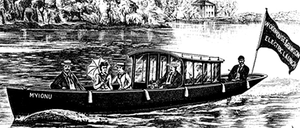Electric Boats
This article was initially published in Today's Engineer on September 2013
The introduction of electric motors in the early 19th century allowed for a number of advancements in the transportation industry. Early motor inventors, including Ányos Jedlik and Thomas Davenport, installed their motors to drive primitive cars. Other inventors turned their attention from land to the sea. Moritz Hermann von Jacobi, a Prussian inventor working in Königsberg, developed an early electric motor in May 1834, and worked on electric cars. Jacobi was invited by Tsar Nicholas I in 1836 to further his development of his motor at the Imperial Academy of Sciences in St. Petersburg. With the tsar’s financial backing, Jacobi installed his motor in a 28-foot paddle boat which was powered by an improved version of his electric motor. The boat made its first trip across the Neva River, carrying 14 passengers, in September 1838, the first documented launch of an electric boat. Using zinc batteries that had 320 pairs of plates and weighed more than 180 kg, the boat was able to travel at a speed of approximately 2.5 km per hour. Over the next few years, Jacobi worked to improve his boat motor design, and by August of 1839 his boat was able to reach a speed of approximately 4 km per hour. Chemistry professor Sibrandus Stratingh of Groningen, Netherlands, also worked on electric car designs and developed an electric boat that he launched in 1840.
Commercial production of electric boats was not yet practical in 1840. Batteries were too large, heavy, and difficult to recharge. French physicist Gaston Planté invented a lead-acid, wet cell, storage battery in 1859, the first commercial rechargeable electric battery. Using two sheets of lead and sulfuric acid, Plante’s battery was a precursor to rechargeable batteries used in modern automobiles. In 1866, George Lechlancé invented a dry cell battery using zinc, manganese, and ammonium chloride. These developments in efficient rechargeable batteries allowed for further motor improvements. Outboard motor designs, such as those invented by William Woodnut Griscom of Philadelphia in 1879 by and Gustav Trouvé in 1880, enabled the commercial production of electric boats.
By 1882, the Electrical Power Storage Company had produced the first commercial river launches on the Thames River in England. The first boat was called Electricity, and was a steel boat 7.6 meters in length. Electricity used batteries that enabled the craft to run for approximately six hours at an average of 13 km per hour. In 1887, Moritz Immisch partnered with Viscount Bury to build a fleet of electric boats along the Thames and charging stations along the riversides. Floating charging stations designed by William Sargeant were introduced in 1888. Working with Magnus Volk, Immisch & Co.’s fleet of six boats was first deployed along the Thames in 1889.
The oldest surviving electric boat is the Mary Gordon, a boat launched on August 2nd, 1900. At 16 m, the Mary Gordon was one of the largest electric boats in service, and could comfortably carry 75 adults. The Mary Gordon’s step controller was similar to contemporary electric trains, and used large and heavy DC motors. In 1905, the 95 foot Victory was constructed, which was the largest electric boat to be in service on the Thames.
The popularity of commercial electric boats declined by the 1920s with the introduction of practical internal combustion engines. However, electric boats were still built for specific purposes, such as environmentally sensitive areas like the Königssee Lake in Germany, which had banned the use of steam and motor boats in 1909. Electric outboard motors remained popular amongst fishermen for trolling.
The military heavily used electric motors in submarines. While the earliest submarines were mechanically powered, the first mass produced military submarines used electric motors while submerged. Irish engineer John Philip Holland spent decades working on submarine designs and improvements, and constructed the Holland VI in 1897. The Electric Boat Company was founded in 1899 to produce Holland’s work. The US Navy purchased the Holland VI, commissioning it as the USS Holland (SS-1) in 1900. The Holland used an electric battery system to power the boat when submerged, and employed a diesel powered internal combustion to propel the boat when on the surface. While nuclear power eventually replaced this system for the larger submarines, electric motors were still used when the craft wanted to be silent, and the combination of diesel and electric power remains a practical solution for smaller submarines.
Commercial electric boats experienced a revival in the latter decades of the 20th century. Duffy Electric Boat Company of California began mass producing small electric craft in 1968, and has produced more than 10,000 boats to date. Boats powered by solar panels emerged in the 1980s, and are a popular choice for electric boating today. The Tûranor PlanetSolar is currently the largest solar-powered boat in the world at 31 meters. Launched in Kiel, Germany, in 2010, it became the first solar-powered electric boat to circumnavigate the world in 2012. September 2013 marks the 175th anniversary of Jacobi’s launch on the Neva and after almost two centuries of development, electric boats continue to provide a clean and quiet method to traverse the planet’s waterways.


